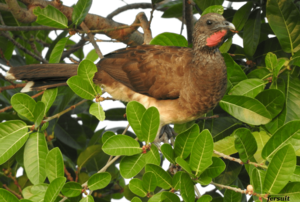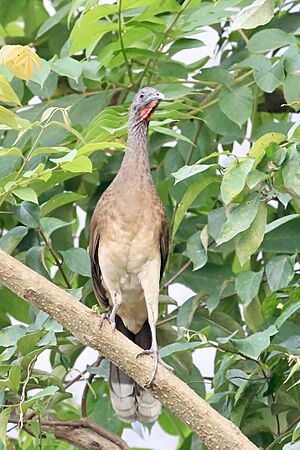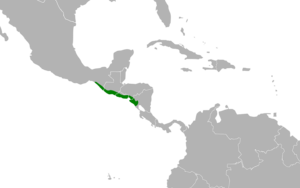White-bellied chachalaca facts for kids
Quick facts for kids White-bellied chachalaca |
|
|---|---|
 |
|
 |
|
| Conservation status | |
| Scientific classification | |
| Genus: |
Ortalis
|
| Species: |
leucogastra
|
 |
|
The white-bellied chachalaca (Ortalis leucogastra) is a type of bird. It belongs to the Cracidae family. This family includes chachalacas, guans, and curassows. You can find this bird in El Salvador, Guatemala, Honduras, Mexico, and Nicaragua.
Contents
About the White-bellied Chachalaca
This bird is about 43 to 50 centimeters (17 to 20 inches) long. It weighs between 439 and 560 grams (about 1 to 1.2 pounds). Its head, upper body, and chest are brown. The belly is a dull white color. Its brown tail has white tips. Around its eyes, the skin is dark and bare.
Where They Live
The white-bellied chachalaca lives in Central America. You can find it from southwestern Mexico down to northwestern Nicaragua. It mostly lives in swamp forests and thick scrub areas. It also lives in dry forests and near pastures. These birds are most common along the Pacific coast. In Guatemala, they can live as high as 1,500 meters (about 4,900 feet) up in the mountains.
How They Behave
What They Eat
White-bellied chachalacas often look for food in groups. These groups usually have six or more birds. They almost always stay high up in trees, about 6 to 10 meters (20 to 33 feet) off the ground. Their main food is berries and fruits. They also eat leaves, buds, flowers, and small insects.
Reproduction and Nests
White-bellied chachalacas lay eggs from March to July. Their nest is a simple platform made of sticks. It is lined with leaves. They build their nests in trees, usually between 5 and 20 meters (16 and 66 feet) high. A female bird lays two or three eggs. Only the female sits on the eggs to keep them warm until they hatch.
Bird Calls
The main sound the white-bellied chachalaca makes is a rough, chattering call. It sounds like "k-ku’uh-uh" or "ch-k-uh-urr."
Conservation Status
The IUCN (International Union for Conservation of Nature) says the white-bellied chachalaca is a species of "Least Concern." This means it is not currently in danger of disappearing. It is common in many places where it lives. However, it is less common in Honduras and Nicaragua.
Sometimes, these birds have benefited when dense forests were changed into coffee farms with shade trees. But in other areas, they have lost their homes. This happens when forests are cleared for pastures and farms. People also hunt these birds for food.


